Art & Exhibitions
‘I Think a Lot of People Misjudged Me’: Tracey Emin Opens Up About Aging, Love, and the Art Scenes That Shut Her Out
The artist has just installed a permanent artwork at Jupiter Artland in Scotland.
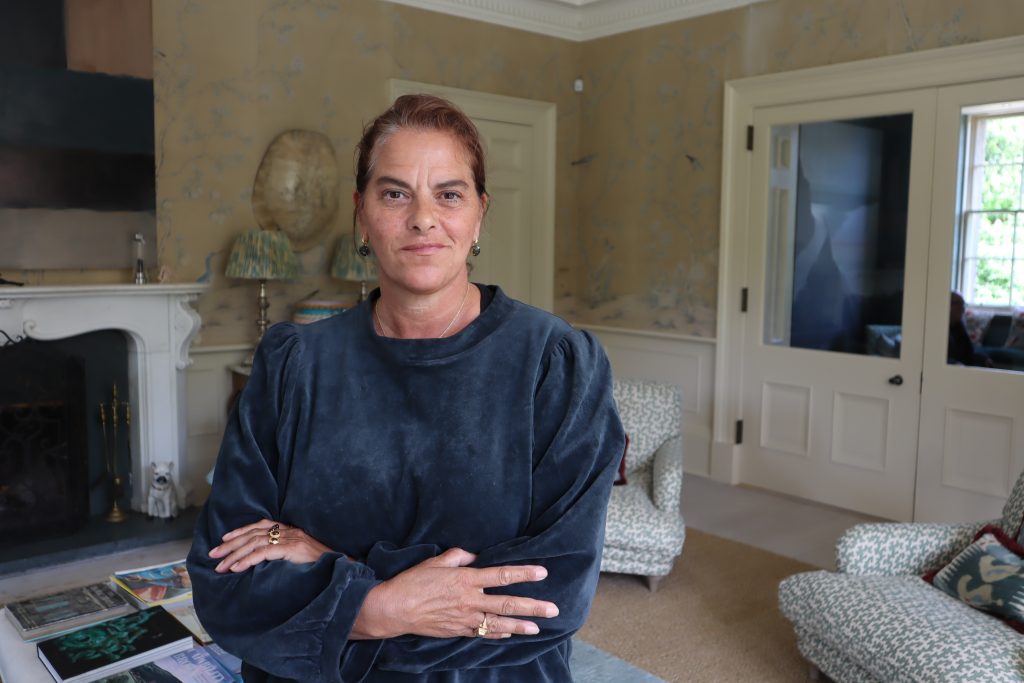
The artist has just installed a permanent artwork at Jupiter Artland in Scotland.

Naomi Rea

It has been just over a year since Tracey Emin was given the all clear from bladder cancer. Following a period of recovery from an extensive surgery, the artist is finally out of bed. So far out of bed, in fact, that I had to trek across a forest in Scotland to meet her.
We met at Jupiter Artland, where Emin has just opened an exhibition originally slated for 2020 but was delayed—first because of the pandemic and then because she was unwell. The artist was in good form as she posed for photographs perched atop a monumental bronze figure that is being permanently installed in the woodland of the 120-acre sculpture park owned by collectors Nicky and Robert Wilson.
The exhibition (through October 2) takes its title from the bronze, I Lay Here for You, a female figure lying on her front, hand disappearing between her thighs. Emin chose the site for the work, which is slanted on a hill, its undulations echoed in the forms of the bronze. It feels like a private scene, but the title adds another layer, suggesting the figure lies in wait, which opens up themes of loneliness, and the human longing for partnership.
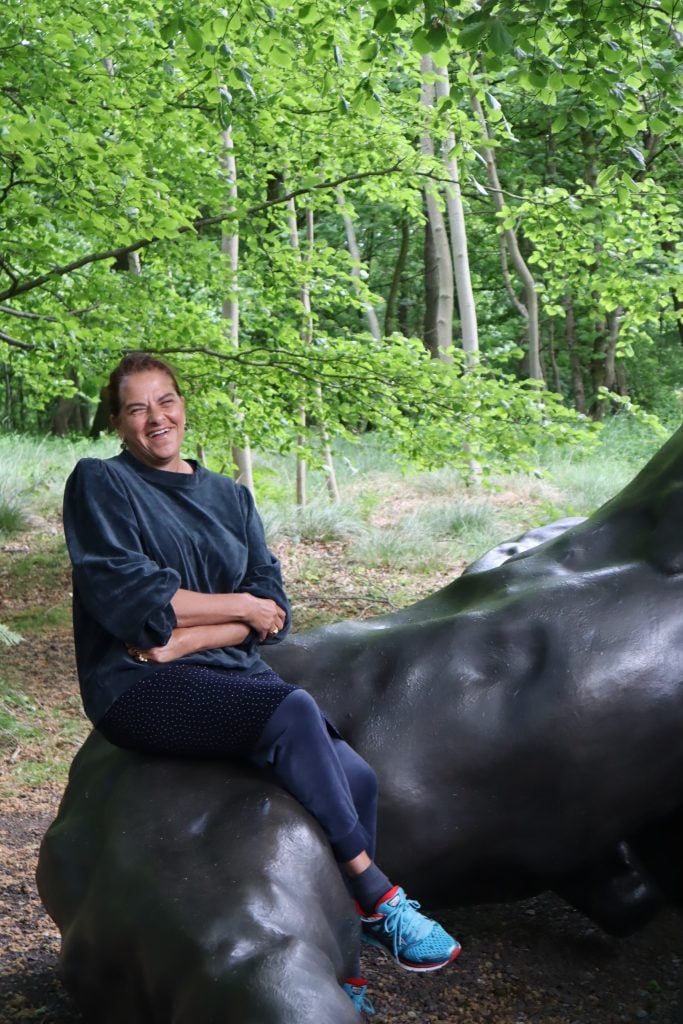
Tracey Emin. Photo by Naomi Rea.
Emin has always been good at carving open spaces to talk about difficult subjects. Her unflinching autobiographical work gives voice to the experience of being a woman, from discovering sexual pleasure to meeting forces that threaten that bodily autonomy, such as sexual violence, shaming, access to abortion, or menopause.
I wondered about how the sculpture would play with school trips to Jupiter Artland, and how it might open up discussions about masturbation. “It’s kind of useful, isn’t it?” Emin said. “It’s a conversation you don’t really want to have in the classroom. It’s better to have it outside in clear air so the words can go off into the ether, or maybe say nothing and just look at it and think, and it becomes an open subject between friends, then.”
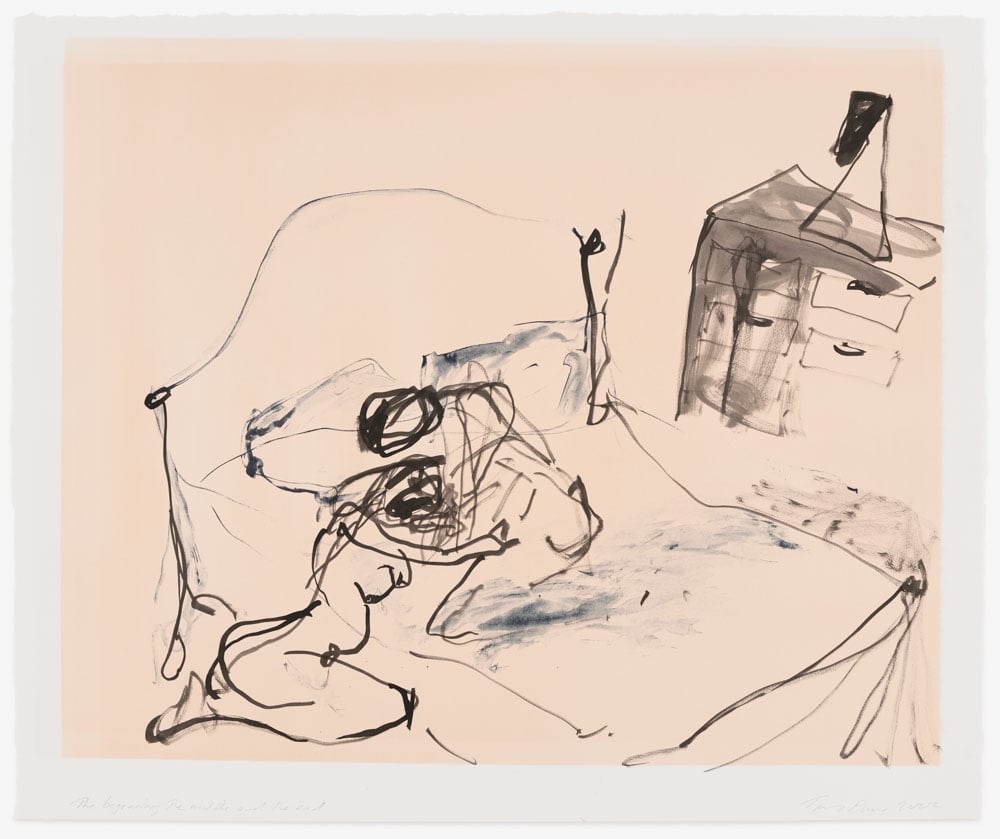
Tracey Emin, The beginning The middle and The end (2022). ©Tracey Emin. All rights reserved, DACS 2020. Photo © White Cube. (Ollie Hammock).
Emin became famous for her provocative pit of depression now known as My Bed (1999), which exploded her onto the scene with the YBAs. It prompted a nationwide debate about what art is, which—as I was reminded by a conversation with my taxi driver on the way out of the sculpture park—continues to this day.
Though Emin’s practice has evolved far beyond the bed over the past two decades, she has returned to the subject among the array of paintings, sculpture, and hand-painted monographs on view in the exhibition.
In one small painting, Empty Heart, a bed far different from her infamous messy tangle appears, this one pristine, awash in pastel hues. It was the last painting she made before moving out of her old apartment in Fitzrovia, London, after 20 years—she now mostly lives in her seaside hometown of Margate—and after her cancer diagnosis. “It was about leaving, and it was about death as well,” Emin told me. “If I died, everything would have been empty.”
In a new series of monotypes made during her recovery, the bed motif recurs, but this time it is full of life. When she was ill, the gallerist Carl Freedman (also her next door neighbor in Margate, and a former lover) printed off a series of lithographs of the outline of her bed to help ease her back into work. “So I could have a starting place, and I didn’t have to think ‘oh what am I going to draw?’” Emin said. “I could just draw on the bed.”
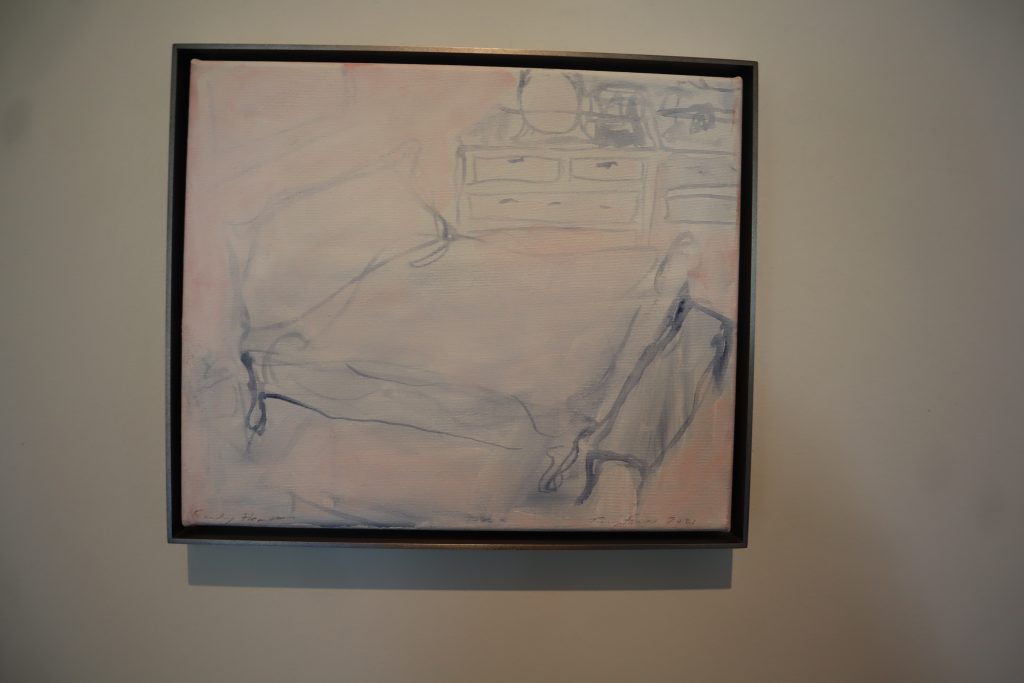
Tracey Emin, Empty Heart (2021). Installation view, “I Lay Here For You,” Jupiter Artland. Photo by Naomi Rea.
Emin worked over the lithographs with Indian ink to produce a series of sexy works that she said draw from “wonderful memories” and are about someone who helped her through difficult moments after her surgery, without getting more specific than that. Some are overtly erotic, sexual scenes paired with poetic, confessional, titles like You just kept wanting me. In others, the title jars emotionally with the physical intimacy depicted: a couple spooning, the female figure turned away; Of course I was Hurt.
Her urostomy bag—a necessity since the cancer surgery removed her bladder, womb, and half of her vagina—makes several appearances. Emin doesn’t shy away from addressing her physical challenges, and emotional hurdles too. She has recently been grappling with a change in how society treats her as she approaches 60 years old.
“I haven’t had children, but I think [menopause] is a lot worse in terms of pain and misery and suffering,” she said. “At least when you give birth, you have a child. After menopause you just have less, and less, and less, and less. It’s the beginning of the end.”
The same air of wistfulness that accompanies the bronze outdoors permeates these works. “They are sad, some of them, and it is also a sad story: I’m not lucky in love, and there’s nothing I can do about it. I just have to accept it as it is,” she said, adding, with a twinge of bitterness: “If I was a man I’d still be a catch. I have quite a lot going for me, I think. But as a woman, it doesn’t work that way.”
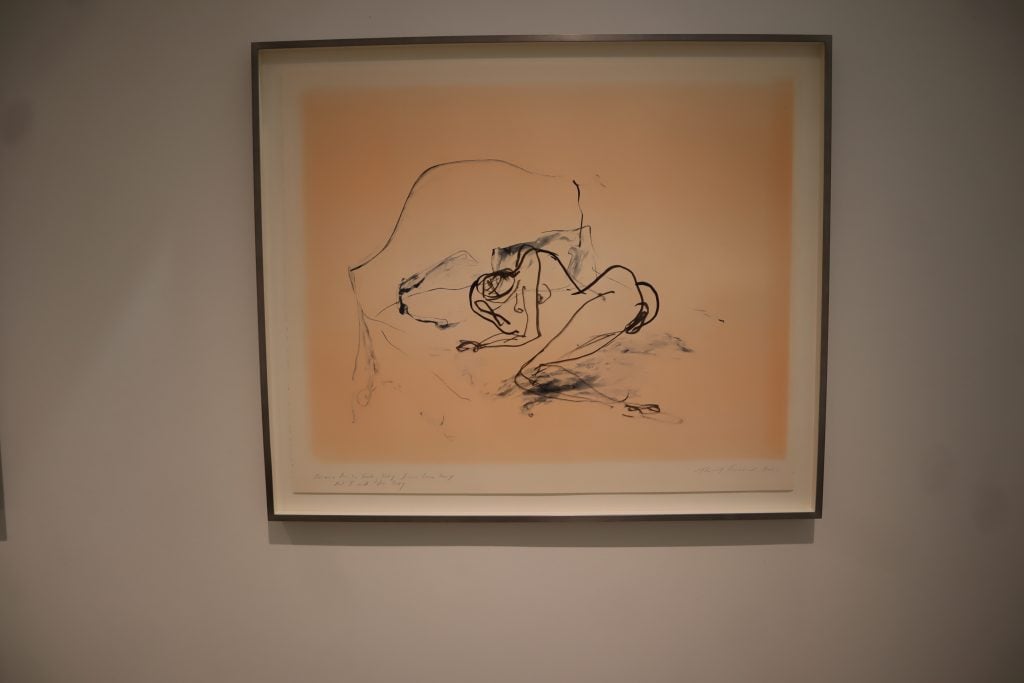
Tracey Emin, Because I’m so Fucking sexy. I was born sexy And I will die sexy (2022). Installation view, “I Lay Here For You,” Jupiter Artland. Photo by Naomi Rea.
As our words wandered in this direction, I felt like shaking her. You’re Tracey Fucking Emin! But where she could have collapsed into self-pity, the conversation turned around. Her confrontation with the cancer also forced her to tackle a deep-seated drinking problem. Now recovered, she has found an emotional level-headedness which has opened up exciting new possibilities in life as in art.
“If someone thinks that my sexuality is what is between my legs, then they’re wrong,” she said. “I’ve got an amazing imagination, and I’m full of fecundity. I’m alive.”
This attitude comes to fruit in one of the most powerful monotypes, titled Because I’m so Fucking sexy. I was born sexy And I will die sexy. In it, Emin appears as a lone figure, filling the bed, reclaiming her sexual self.
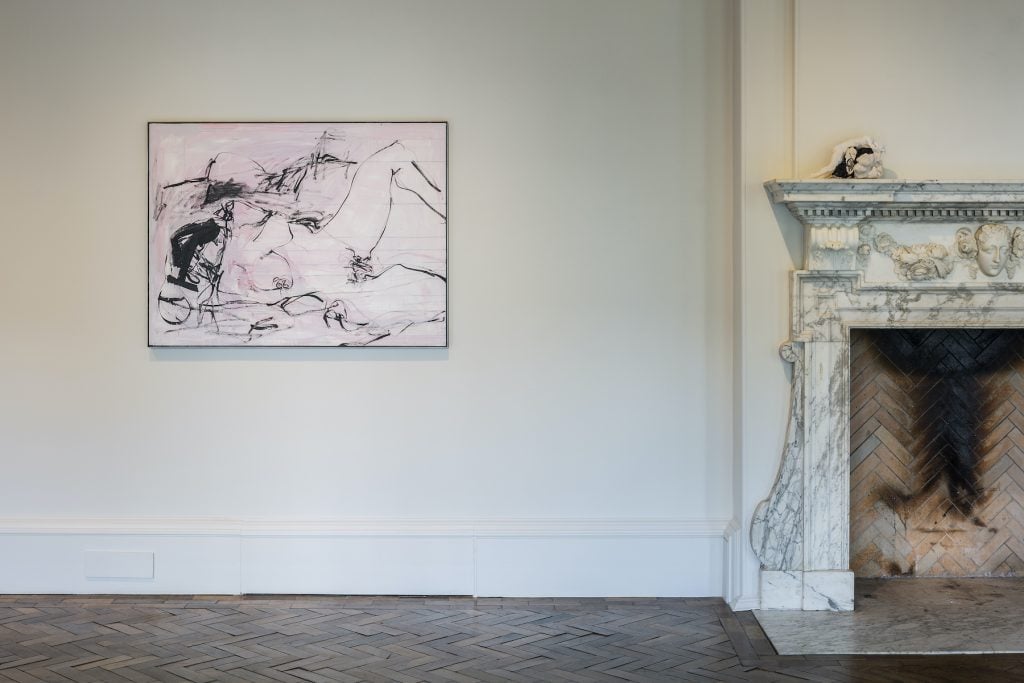
Installation view, “Tracey Emin: I Lay Here For You,” Jupiter Artland. Photo by Keith Hunter.
Emin’s personal emotional development has coincided with a critical reassessment of her career, and belated recognition of work that was dismissed when it was first made.
In recent years, her paintings have been shown alongside those of Edvard Munch; My Bed has been shown with JMW Turner, and people are coming around to some of her more challenging film works. One haunting film on view in Scotland, which is not technically part of the exhibition but a recent acquisition from the owners of the sculpture park, can be heard from the forest. In the 1998 Super 8 film Homage to Edvard Munch and all my dead children Emin is curled up, naked, on the jetty outside Munch’s studio in Oslo, wailing.
“As an artist, it’s been really difficult for me. I think a lot of people misjudged me, got me wrong,” Emin said. “But I think I feel slowly things are changing for me. People are starting to realize that I wasn’t a screaming banshee. I actually was making some really good points.”
Still, not everyone has come around. While she is now a towering figure in British art, who has shown in major museums around the world, Emin has yet to get proper recognition in the U.S. Barring one show of neon works at MOCA North Miami, Emin has never had a solo exhibition at an American museum. She puts it down to the conservative powers that be in the U.S. museum world. “The board is never going to clear my work,” she said. “It’s never going to happen.”
She has felt left out of certain group shows too, including political art shows where she said her abstract, emotional work has been passed over for those that favor figurative, direct statements. “They say my work is not political,” she said. “Give me a show in Texas and tell me whether my work’s political. Go on.”
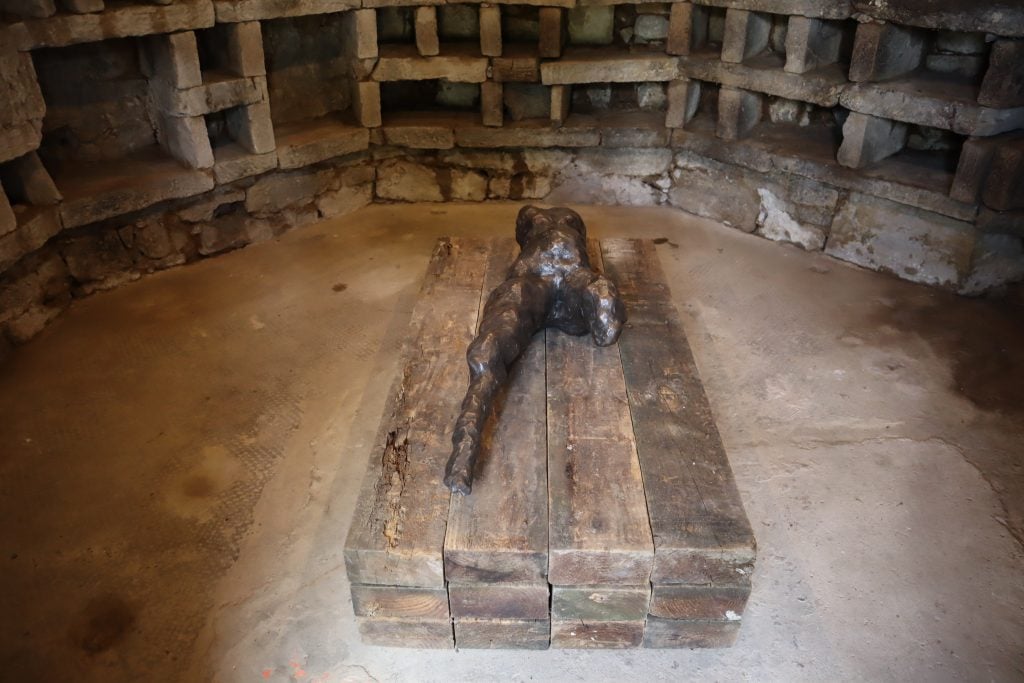
Tracey Emin, This is exactly how I feel right now (2016). Installation view, “I Lay Here For You,” Jupiter Artland. Photo by Naomi Rea.
Elsewhere, she is being recognized through a slew of shows including a solo at Carl Freedman gallery in Margate, and besides Scotland, permanent works are being installed in Israel, and her Sphinx-like, 30-foot-tall, 18.2 ton sculpture The Mother is about to be unveiled outside the Munch Museum in Oslo.
Back on home soil, she is setting up her own free-to-attend art school in Margate to give opportunity to those who might otherwise have been deprived, and where she intends to pass on her wisdom. “I’ll teach people how to make a living out of their art so they don’t have to do cleaning jobs if they don’t want to,” she said. All this, and making plans to open up her studio complex as a museum after she dies, has her thinking about legacy.
The permanent bronze works going into the ground give her a sense of validation she hasn’t felt during the fleeting periods of fame that have punctuated her career. “They’re not going anywhere,” she said. And for now, armed with a clean bill of health and emotional steadiness, neither is Emin.
“Tracey Emin: I Lay Here For You” is on view through October 2 at Jupiter Artland, Wilkieston, Scotland.